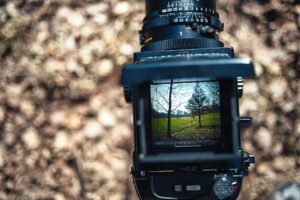CTR Photography
EXPLORING MEDIUM FORMAT FILM PHOTOGRAPHY

EXPLORING MEDIUM FORMAT FILM PHOTOGRAPHY
Medium format film photography refers to the use of film that is larger than 35mm (24mm x 36mm) but smaller than 4 in x 5 in.
The most common medium format film, also known as 120 film, is approximately 6 cm tall, and the common image sizes are 6 x 4.5 cm, 6 x 6 cm, and 6 x 7 cm
Introduction:
Photography is an art form that has evolved significantly over the years. From the early days of daguerreotypes to the digital age, photographers have always sought ways to capture the world around them in ever more detailed and creative ways.
One such method that has stood the test of time is medium format film photography.
What is Medium Format Film Photography:
Medium format film photography refers to the use of film that is larger than 35mm (24mm x 36mm) but smaller than 4 in x 5 in.
The most common medium format film, also known as 120 film, is approximately 6 cm tall, and the common image sizes are 6 x 4.5 cm, 6 x 6 cm, and 6 x 7 cm.
Why Choose Medium Format?
There are several reasons why photographers choose to shoot with medium format film cameras:
Higher Quality Images
The increased size of medium format film means a much larger negative.
This will give you finer details and less grain. You also get smoother tones with a wider range of colours.
Shallower Depth of Field
Medium format film cameras have a wider field of view compared to 35mm cameras when you’re using lenses with similar focal lengths.
That large negative lets you see more of the scene you’re shooting than you would with a 35mm camera.
This gives the appearance of a shallower depth of field for your apertures.
Getting Started with Medium Format Film Photography
Medium format film cameras can be found at any budget, opening up this style of shooting to pretty much everyone.
However, it can often feel intimidating to new film photographers.
Therefore, it’s important to understand what medium format film photography is, why people shoot it, and some of the common terms and definitions.
Conclusion
Medium format film photography offers a unique way to capture the world around us.
With its larger negative size and the ability to produce high-quality images, it’s no wonder that many photographers, both amateur and professional, are drawn to this timeless method of photography.
Whether you’re a seasoned photographer looking to try something new or a beginner interested in exploring the world of film, medium format film photography offers a rewarding and creative experience.
So why not give it a try?
You might just find your new favourite way to capture the world around you.
Here are some tips for shooting medium format film:
Understand Your Camera:
Medium format cameras can be quite different from the 35mm or digital cameras you might be used to.
Choose the Right Film:
In medium format film, your ISO is a fixed measurement of the sensitivity of your roll of film.
For at least 12 shots at a time you can’t change it. 160 speed film is best for outdoors. 400 and 800 speed are common for indoors.
Focus on Composition:
The larger negative size of medium format film can provide a different perspective and field of view.
Use this to your advantage when composing your shots.
Overexpose Your Shots:
In film photography, it is better to overexpose. It is easier to bring the exposure down later.
You’re able to push or pull a film if you would like to change the exposure while developing.
Experiment and Practice:
As with any form of photography, the best way to improve is to practice.
Don’t be afraid to experiment with different subjects, lighting conditions, and compositions
Remember, the key to great photography is not just the camera or the film, but the photographer.
Happy shooting!